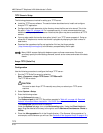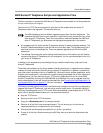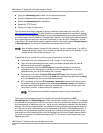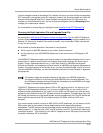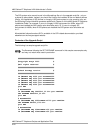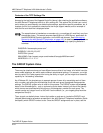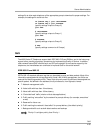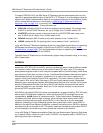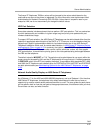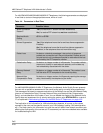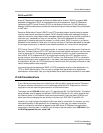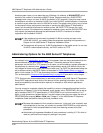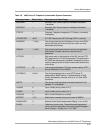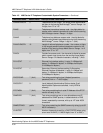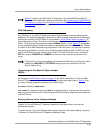
4600 Series IP Telephone LAN Administrator’s Guide
QoS
4-26
To support IEEE 802.1D/Q, the 4600 Series IP Telephones can be administered either from the
network via appropriate administration of the DHCP or TFTP servers, or at the telephone itself via
dialpad input. Specific implementation details for local administration are in the Installation Guide,
and for remote administration are in this chapter, in 4600 Series IP Telephone Scripts and
Application Files, on page 4-19. In summary, four IEEE 802.ID/Q QoS parameters in the
telephones can be administered. These parameters are:
■ L2QVLAN: setting the VLAN ID on which the telephone should operate. For example, what
VLAN ID to use for DHCP Discovery, etc. (up to 4 digits, from 0 to 4094, default is 0).
■ VLANTEST: setting the number of seconds to wait for a DHCPOFFER when using a non--
zero VLAN ID (up to 3 digits, from 0 to 999, default is 60).
■ L2QAUD: setting the 802.1Q audio priority value (between 0 and 7, default is 6)
■ L2QSIG: setting the 802.1Q signaling priority value (between 0 and 7, default is 6)
In the 4600 Series IP Telephone Installation Guide, the Local Administrative Option for specifying
ADDResses also allows you to specify VLAN IDs and VLANTEST values (see also VLAN
Considerations, on page 4-29). The Local Administrative Option for specifying QoS values allows
you to specify values for L2QAUD and L2QSIG.
The 4600 Series IP Telephones can simultaneously support receipt of packets using, or not using,
802.1Q parameters.
DIFFSERV 4
As defined in IETF RFCs 2474 and 2475, “services” are basically ways of treating different subsets
of a network’s traffic in different ways at the Internet Protocol (IP) layer, Layer 3. For example,
some packets might be routed in such a way as to expedite delivery (minimize delay), while others
are routed to minimize loss, minimize cost, etc. The differentiation between these services (that is,
Differentiated Services) is provided by a redefinition of an octet in the Layer 3 headers for IP
versions 4 and 6, also termed IPv4 and IPv6, respectively. This octet is called a Type of Service
(TOS) octet in IPv4 and a Traffic Class octet in IPv6, but in both cases the octet is interpreted
differently than it was originally defined. With Differentiated Services, bits 0 through 5 of the octet
identify a Differentiated Services Code Point (DSCP) that identifies a procedure to be used to
handle that packet on a per-hop basis. Bits 6 and 7 of the octet are currently unused, and are
ignored by DSCP-compliant routers.
With DiffServ, the default DSCP is all zeroes, and represents “no special handling.” RFC 2474 also
defines eight “Class Selector Codepoints,” which are the eight DSCP encodings that can be
represented by xxx000 (where “x” represents one bit). These Code Selector Codepoints are
considered prioritized, with the larger numerical values having a higher relative order. DSCP-
compliant routers should treat larger-valued DSCPs in such a way as to give the associated
packets a “probability of timely forwarding” greater than a packet with a lower-valued DSCP. In
addition to the eight Class Selector Codepoints, a network may define its own DSCPs by defining
encodings that do not terminate in 000. The specific treatment intended by these custom DSCPs
will not necessarily be carried out by routers outside the customer’s own network.
In the 4600 Series IP Telephone Installation Guide, the Local Administrative Option for QoS allows
you to specify Diffserv values for Layer 3 audio (“L3QAUD”) and signaling traffic (“L3QSIG”) on a
phone-by-phone basis if necessary.



